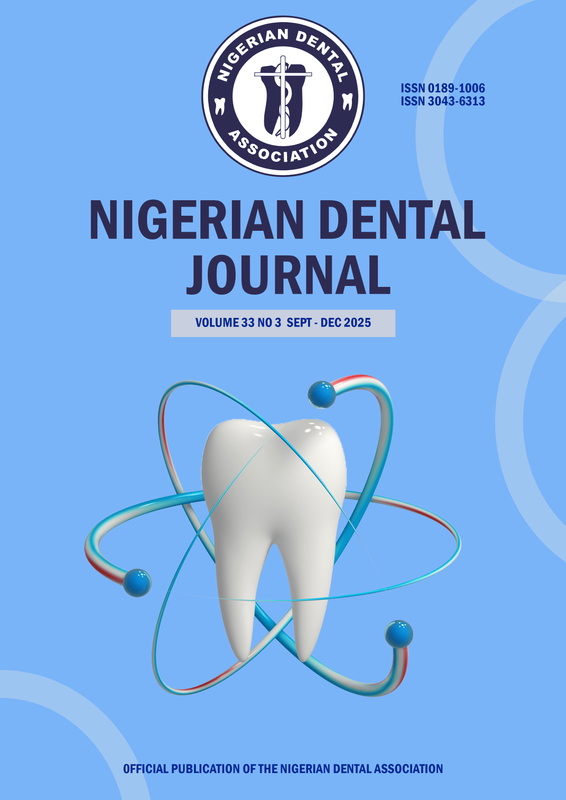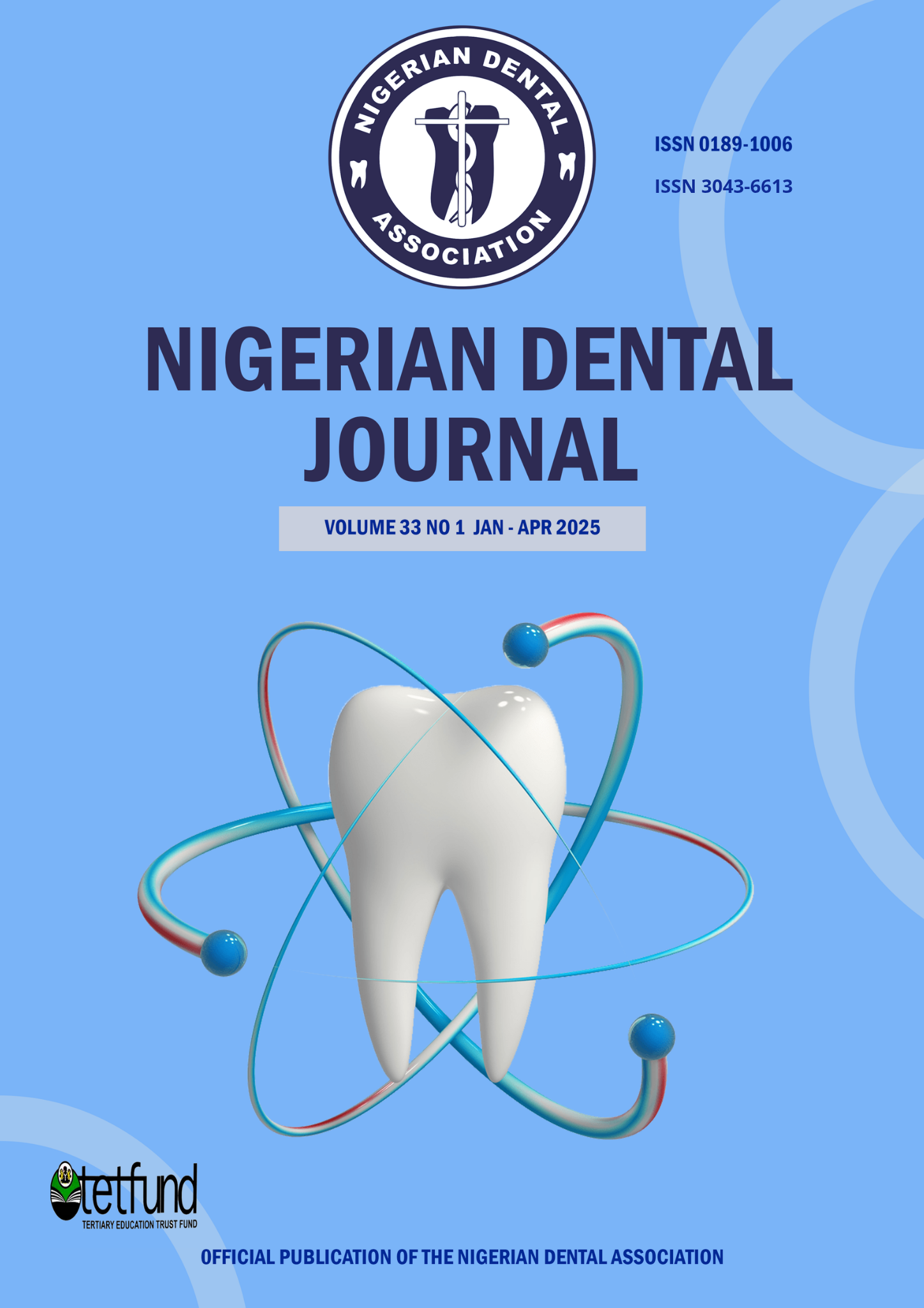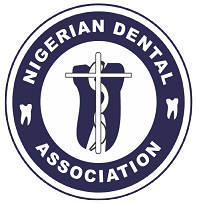Does Gingival Biotype Affect the Prevalence of Gingival Recession Among Patients at a Tertiary Hospital in Nigeria?
DOI:
https://doi.org/10.61172/9r81sa82Keywords:
Gingival biotype, Gingival recession, Patients, PrevalenceAbstract
Objectives: To investigate the type of gingival biotype, present among participants who attended the Periodontology clinic of the University of Port Harcourt Teaching Hospital (UPTH), Rivers State and to assess the effect of the types of gingival biotype on the prevalence of gingival recession.
Materials and Methods: This was a cross-sectional study conducted among patients who attended the Periodontology clinic at the University of Port Harcourt Teaching Hospital (UPTH). Ethical approval was obtained from the Health Research and Ethics Committee of the Institution. Participants’ consents were obtained before the study was commenced. Data was collected using semi-structured, self-administered questionnaire. The questionnaire had three sections: section A included information on socio-demographic characteristics, section B included information about oral hygiene practices of the participants, while section C included intraoral examination to determine the type of gingival biotype and presence of gingival recession on the six maxillary anterior teeth at the mid-buccal area of the tooth. The gingival biotype was determined using the probe transparency method, based on the visibility of the underlying Williams probe through the gingiva tissue.
Statistical analysis was done using the Statistical Product and Service Solution, SPSS version 25.0 (IBM SPSS Inc. Chicago, Illinois). statistical significance was considered at p ≤ 0.05.
Results:
Ninety-eight participants participated in the study, fifty-five (56.1%) were females while 43(43.9%) were males. Sixty-seven (68.4%) of participants cleaned their teeth once daily.
The prevalence of gingival recession was 23.47%. Majority (82.7%) of the participants had thick gingival biotype, while 17.3% had thin gingival biotype. Majority of the younger participants had thick gingival biotype, while the elderly participants had thin gingival biotype, (p<0.026). Based on gender, 47(85.5%) and 34(79.1%) of females and males respectively had thick gingival biotype (p=0.407). About 18.5% of participants with thick gingival biotype presented with gingival recession while 47.1% of participants with thin gingival biotype had gingival recession.
Conclusion:
Majority of the participants presented with thick gingival biotype. The prevalence of gingival recession in this study was statistically associated with the age of the participants, type of gingival biotype, type of toothbrush and tooth brushing method used. Gingival recession was more common in participants with thin gingival biotype.
Downloads
References
Kumar A. Gingival recession: Narrow perception - erroneous; wider canvass - out-of-focus! J Indian Soc Periodontol. 2023;27(3):227-229. doi: 10.4103/jisp.jisp_118_23.
Imber JC, Kasaj A. Treatment of Gingival Recession: When and How? Int Dent J. 2021;71(3):178-187. doi: 10.1111/idj.12617.
Wagner T, Costa RSA, Rios FS, Moura MS, Maltz M, Jardim JJ, et al. Gingival recession and oral health‐related quality of life: A population‐based cross‐sectional study in Brazil. Community Dent Oral Epidemiol 2016;44:390–399.
Kassab M, Cohen R. The aetiology and prevalence of gingival recession. J Am Dent Assoc 2003;134(2):220-225
Jati AS, Furquim LZ, Consolaro A. Gingival recession: its causes and types, and the importance of orthodontic treatment. Dental Press J Orthod. 2016;21(3):18-29. doi: 10.1590/2177-6709.21.3.018-029.oin.
Susin C, Haas AN, Oppermann RV, Haugejorden O, Albandar JM. Gingival recession epidemiology and risk indicators in a representative urban Brazilian population. J Periodontol. 2004;75(10):1377–86).
Renkema AM, Fudalej PS, Renkema AAP, Abbas F, Bronkhorst E, Katsaros C. Gingival labial recessions in orthodontically treated and untreated individuals – a pilot case-control study. J Clin Periodontol. 2013; 40(6):631–7).
Pires IL, Cota LO, Oliveira AC, Costa JE, Costa FO. Association between periodontal condition and use of tongue piercing: a case-control study. J Clinical Periodontol. 2010;37:712–8
Dilsiz A, Aydin T. Gingival recession associated with orthodontic treatment and root coverage. J Clin Exp Dent. 2010;2:e30–3.
Joshua Hudson, Ulpee Darbar. Gingival recession. Part 1: prevalence and aetiology
Dent Update 2024 51:3, 707-709.
Abraham S, Deepak K, Ambili R, Preeja C, Archana V. Gingival biotype and its clinical significance – A review. Saudi J Dent Res 2014;5(1):3-7. https://doi.org/10.1016/j.ksujds.2013.06.003
Ochsenbien C, Ross S. A re-evaluation of osseous surgery Dent Clin North Am 1969;13(1):87-102
Olegivna IM The modern view on etiology and pathogenesis of gum recession (review of the literature) Pharm Innov 2018;7(7):176-179
Kao RT, Pasquinelil K. Thick vs Thin gingival tissue: a key determinant in tissue response to disease and restorative treatment. J Calif Dent Assoc 2002;30 (7):521-526
Singh M, Chaubey KK, Madan E, Thakur RK, Agarwal MC, Joshi N. Correlation between gingival biotype and occurrence of gingival recession. Saudi J Oral Dent Res. 2016;1(3):119-123
Joshi N, Agarwal MC, Madan E, Gupta S, Law A. Gingival biotype and gingival bioform: Determining factors for periodontal disease progression and treatment outcome. Int J Sci Stud 2016;4:220-5
Koppolu P, Al arabi AA, Al Khayri MJ, Alfaraj FA, Alsafwani WM, Alhozaimi SF,et al. Correlation between gingival thickness and occurrence of gingival recession. J Pharm Bioallied Sci 2023;15(Suppl 1): S495-S501.
Egreja AMC, Kahn S, Barceleiro M, Bittencourt S. Relationship between the width of the zone of keratinised tissue and thickness of gingival tissue in the anterior maxilla. Int J Periodontics Restorative Dent. 2012;32(5):573-9
De Rouck T, Eghbali R, Collys K, De Bruyn H, Cosyn J. The gingival biotype revisited: Transparency of the periodontal probe through the gingival margin as a method to discriminate thin from thick gingiva. J Clin periodontal 2009;36:428-433
Bednarz W, Zielinska A. Ultrasonic biometer and its usage in an assessment of periodontal soft tissue thickness and comparison of its measurement accuracy with bone sounding method. Dent Med Probl. 2011;48(4):481-9.
Stein JM, Lintel-Höping N, Hammächer C, Kasaj A, Tamm M, Hanisch O. The gingival biotype: measurement of soft and hard tissue dimensions - a radiographic morphometric study. J Clin Periodontol. 2013;40:1132–9.
Shah HK,Sharma S, Shrestha S. Gingival biotype classification, assessment and clinical importance: A review. JNSPOI 2021;4(2):83-88
Kan JYK, Rungcharassaeng K, Umezu K, Kois JC. Dimension of peri-implant mucosa: An evaluation of maxillary anterior single implants in humans. J Periodontol. 2003;74 (4):557-562
De Rouck T, Eghbali R, De Bruyn H, et al. The gingival biotype revisited: Transparency of the periodontal probe through the gingival margin as a method to discriminate thin from thick gingiva. J Clin Periodontol 2009;36:428-433.
Pashova-Tasseva Z, Mlachkova A, Tosheva E Impact of gingival phenotype on the periodontal disease. Folia Med 2023; 65(3):468-475
Assiri M, Shafik S, Tawfig A. Association between gingival tissue biotype and different facial phenotypes. Saudi Dent J 2019;31:476-480
Shah R, Sowmya NK, Mehta DS. Prevalence of gingival biotype and its relationship to clinical parameters. Contemp Clin Dent. 2015;6(Suppl 1):S167-S171
Subedi S, Ranjit R, Bista S. Clinical Evaluation of Gingival Biotype and its Association with Age and Gender Among Patients Visiting a Tertiary Care Center. JCMS Nepal. 2022; 18(4); 358-64.
Agarwai V, Sunny, Mehrotra N, Vijay V. Gingival biotype assessment: variations in gingival thickness with regard to age, gender and arch location. Indian J Dent Sci 2017;9:12-15
Sharma P, Bawa SKS, Chauhan P, Malhotra D. Gingival Biotype: A Key to Successful Aesthetics–Its Role and Functions–Observation-Based Research. EJDENT [Internet]. 2024 Apr. 12 [cited 2024 Aug. 7];5(2):9-12. Available from: https://ejdent.org/index.php/ejdent/article/view/212
Manjunath RG, Rana A, Sarkar A. Gingival Biotype Assessment in a Healthy Periodontium: Transgingival Probing Method. J Clin Diagn Res. 2015 May;9(5):ZC66-9. doi: 10.7860/JCDR/2015/13759.5956.
Rashid R, Ul-Ayoub W. Prevalence of gingival biotype in accordance with age and gender in Kashmiri population. 2017;3(4):111–3.
Mallikarjuna D, Shetty M, Fernandes A, Mallikarjuna R, Iyer K. Gingival biotype and its importance in restorative dentistry: A pilot study. J Interdiscip Dent. 2016;6(3):116–20. DOI: 10.4103/2229-5194.201651
Zawawi KH, Al-harthi SM, Al-Zahrani MS. Prevalence of gingival biotype and its relationship to dental malocclusion. Saudi Med J 2012;33(6):671-675
Barakat H, Dayoub S. Prevalence of gingival biotype in a Syrian population and its relation to tooth shapes: A cross-sectional study. J BioMed sci and Eng 2016;9:141-146
Osadolor OO, Akaji EA, Onyejaka NK, Osadolor AJ. Gingival Recession in a Rural Community in Nigeria: A Pilot Study. IOSR J Dent Med Sci 2020;19(5):34-39
Nwhator SO, Ogunbodede E, Adedigba M, Sagay D. Prognostic indicators of gingival recession in Nigeria: preliminary findings; TAF Prev Med Bull 2010;9(3):187-194.
Soroye MO, Osagbemiro BB. Prevalence, risk factors and pattern of distribution of Gingival Recession in UPTH. The Nig Health J 2019;18(3):114-20.
Chung DM, Oh TJ, Shotwell JL, Misch CE, Wang HL. Significance of keratinized mucosa in maintenance of dental implants with different surfaces. J Periodontol 2006;77:1410-20.
Kao RT, Fagan MC, Conte GJ. Thick vs. Thin Gingival Biotypes: A Key Determinant in Treatment Planning for Dental Implants. J Calif Dent Asso 2008;36:193-198.
Singh M, Chaubey KK, Madan E, Thakur RK, Agarwal MC, Joshi N. Correlation between Gingival Biotype and Occurrence of Gingival Recession. Saudi J Oral Dent Res. 2016;1:119-123
Humagain M, Kafle D. The Evaluation of Prevalence, Extension and Severity of Gingival Recession among Rural Nepalese Adults. Orthod J Nepal, 2013; 3:41-46
Adamu VE, Eneojo NIF, Eze CJ. Toothbrushing techniques among pupils attending a Nigerian unity basic school. Orap J 2020;1(1): e703
Salzer S, Graetz C, Dorfer CE, Slot DE, VanderWeijden FA. Contemporary practices for mechanical oral hygiene to prevent periodontal disease. Periodontol 2000 2020;84:35-44
Downloads
Published
Issue
Section
License
Copyright (c) 2025 Grace Alade, Ayamma Umanah-Edeani

This work is licensed under a Creative Commons Attribution 4.0 International License.
Open Access Statement
- We became fully Open Access since January 2023.
- Our new and archived materials are available free of charge on open basis and under a Creative Commons license as stated below.
Copyright statement
Copyright © 1999 The authors. This work, Nigerian Dental Journal by Nigerian Dental Association is licensed under Creative Commons Attribution 4.0 International License.


